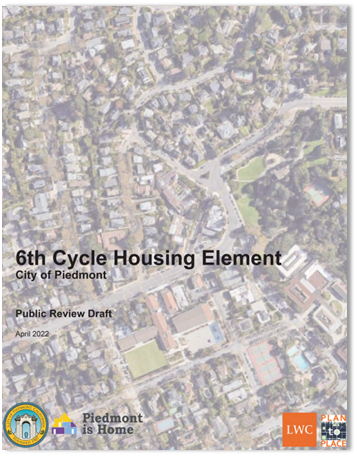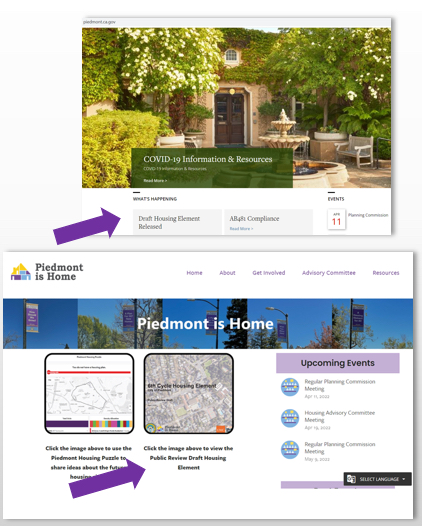On Thursday, May 12, 2022, the Planning Commission will hold a special meeting to consider the Draft 6th Cycle Piedmont Housing Element (Draft Housing Element). On April 8, 2022, the City published the Draft Housing Element for public review and comment. The Draft Housing Element is posted to the homepages of the City of Piedmont website and Piedmontishome.org. Other formats of the Draft Housing Element are available upon request.
The May 12, 2022, Planning Commission agenda is posted on community bulletin boards and to the Planning Commission page of the City website here. The staff report is posted here. The meeting will be held at City Hall at 5:30 pm and can be viewed on KCOM (learn more HERE.)
Provide feedback
Everyone that lives, works, attends school, or cares about housing in Piedmont is encouraged to review the Draft Housing Element and provide comments to City decision-makers. Comments can be made using any of the following methods.
- Email: Piedmontishome@piedmont.ca.gov
- Use the Share Your Voice tool on the homepage at https://Piedmontishome.org
- Mail to: Draft Housing Element, 120 Vista Avenue, Piedmont, CA 94611
- Attend a public meeting: Planning Commission is May 12, 2022, starting at 5:30 pm.
Learn more
Watch these short videos for 10 things you need to know about the Housing Element. Topics covered in the videos include:
- What is the RHNA?
- What is the Housing Element?
- What are the components of the Housing Element and General Plan?

The 374-page Draft Housing Element, shown above, includes policies to increase housing access and affordability in Piedmont. 
Purple arrows identify the locations of the links to the Draft Housing Element on the homepages of the City website and Piedmontishome.org.
Housing Element Update Timeline
- May 12, 2022: Special Planning Commission public hearing, starting at 5:30 pm.
- June 2022: City Council public hearing
- May 2023: Deadline for adoption of the final draft of the updated Housing Element, date amended due to recent state law requiring additional review and longer comment periods.
Here is everything that is in the Housing Element. There’s a lot more to it than just ADU and Blair Park.
Goal 1 Policies
• Policy 1.1: Adequate Sites
• Policy 1.2: Housing Diversity
• Policy 1.3: Promoting Residential Use
• Policy 1.4: Context-Appropriate Programs
• Policy 1.5: Accessory Dwelling Units
• Policy 1.6: Accessory Dwelling Units in New or Expanded Homes
• Policy 1.7: Housing in Commercial Districts
• Policy 1.8: Mobile and Manufactured Housing
• Policy 1.9: Maintaining Buildable Lots
• Policy 1.10: Lot Mergers
• Policy 1.11: Intergovernmental Coordination
• Policy 1.12: Multi-family Housing City Service Fee
• Policy 1.13: Remediation Grants
Goal 1 Programs
• Program 1.A: Vacant Land Inventory
• Program 1.B: Market-Rate Accessory Dwelling Units
• Program 1.C: Public Engagement for Accessory Dwelling Units
• Program 1.D: Allow Religious Institution Affiliated Housing Development in Zone A
• Program 1.E: Require ADUs for New Single-Family Residence Construction
• Program 1.F: Increase Allowances for Housing in Zone B
• Program 1.G: Facilitating Multi-family Development in Zone C
• Program 1.H: Increase Allowances for Housing in Zone D
• Program 1.I: Lot Mergers to Facilitate Housing in Zone C and D
• Program 1.J: SB 9 Facilitation Amendments
• Program 1.K: City Services Impact Fee for Multi-family Housing
• Program 1.L: Specific Plan
• Program 1.M: Manufactured and Mobile Homes
• Program 1.N: Municipal Services Parcel Study Tax
• Program 1.O: Gas Station Remediation Study
• Program 1.P: General Plan Amendments
ATTACHMENT B
Page 17 of 105
Goal 2 Policies
• Policy 2.1: Encouraging Private Reinvestment
• Policy 2.2: Public Funds for Housing Maintenance
• Policy 2.3: Availability of Small, More Affordable Homes
• Policy 2.4: Code Enforcement
• Policy 2.5: Use of Original Materials
• Policy 2.6: Preservation of Multi-Family Housing
• Policy 2.7: Home Occupations
• Policy 2.8: Conservation of Rental Housing Opportunities
Goal 2 Programs
• Program 2.A: CDBG Funding
• Program 2.B: Availability of Small Homes
• Program 2.C: Use of Original Materials and Construction Methods
• Program 2.D: Condominium Conversions
Goal 3 Policies
• Policy 3.1: Rent-Restricted Accessory Dwelling Units
• Policy 3.2: Occupancy of Permitted Accessory Dwelling Units
• Policy 3.3: Legalization of ADUs
• Policy 3.4: Accessory Dwelling Unit Building Regulations
• Policy 3.5: Density Bonuses
• Policy 3.7: Room Rentals
• Policy 3.8: Inclusionary Housing
Goal 3 Programs
• Program 3.A: Affordable Accessory Dwelling Unit Public Information Campaign
• Program 3.B: Increase Number of Legal Accessory Dwelling Units
• Program 3.C: Monitoring Accessory Dwelling Unit Missed Opportunities
• Program 3.D: Monitoring Additional Accessory Dwelling Unit Development Opportunities
• Program 3.E: Affordable Housing Fund
• Program 3.F: Incentives for Rent-Restricted ADUs
• Program 3.G: Inclusionary Housing
Goal 4 Policies
• Policy 4.1: Communicating Planning and Building Information
• Policy 4.2: Planning and Building Standards
• Policy 4.3: Expeditious Permitting
• Policy 4.4: Updating Standards and Codes
• Policy 4.5: Code Flexibility
• Policy 4.6: Housing Coordinator
• Policy 4.7: Infrastructure Maintenance
• Policy 4.8: Infrastructure Prioritization for Lower Income Housing
• Policy 4.9: Housing Finance Programs
ATTACHMENT B
Page 18 of 105
Goal 4 Programs
• Program 4.A: Media Strategy
• Program 4.B: Home Improvement Workshops
• Program 4.C: Building Code Updates and Ongoing Enforcement
• Program 4.D: Fee Review
• Program 4.E: Temporary Staff Additions
• Program 4.F: Capital Improvement Plan (CIP) Updates
• Program 4.G: Monitoring the Effects of the City Charter
• Program 4.H: Consider Modifications to Charter Regarding Zoning Amendments
• Program 4.I: Health and Safety Code 17021.5 Compliance
• Program 4.J: Small Lot Housing Study
• Program 4.K: Small Lot Affordable Housing Study
• Program 4.L: Allow Parking Reductions for Multi-Family, Mixed-Use, and Affordable Projects
• Program 4.M: Facilitate Multi-Family and Residential Mixed-Use Projects by Right Subject to
Objective Standards
• Program 4.N: Allow Transitional and Supportive Housing by Right in Zones that Allow Residential
Uses
• Program 4.O: Allow Low Barrier Navigation Centers by Right in Zones that Allow Residential
Uses
• Program 4.P: Residential Care Facilities
• Program 4.Q: Parking Reductions for Persons with Disabilities, Seniors, and Other Housing
Types
• Program 4.R: Permit Streamlining
• Program 4.S: Prioritize Sewer Hookups for Residential Development for Lower-Income Housing
• Program 4.T: Establish Standards for Emergency Shelters
Goal 5 Policies
• Policy 5.1: Retrofits for Diminished Mobility of Piedmont Residents
• Policy 5.2: Accessory Dwelling Units, Shared Housing, and Seniors
• Policy 5.3: Reasonable Accommodation
• Policy 5.4: Extremely Low-Income Residents
• Policy 5.5: Regional Approaches to Homelessness
• Policy 5.6: Foreclosure
• Policy 5.7: Persons with Disabilities
Goal 5 Programs
• Program 5.A: Shared Housing Publicity and Media Initiative
• Program 5.B: Shared Housing Matching Services
• Program 5.C: Assistance to Nonprofit Developers
• Program 5.D: Accommodations for Disabled Persons
• Program 5.E: Housing Support for Families in Crisis
• Program 5.F: EveryOne Home
• Program 5.G: Faith Community Participation
• Program 5.H: Housing for Extremely Low-Income Individuals and Households
ATTACHMENT B Page 19 of 105
• Program 5.I: Housing for Extremely Low-Income Families
• Program 5.J: Developmentally Disabled Residents
• Program 5.K: Transitional and Supportive Housing for Extremely Low-Income Residents
Goal 6 Policies
• Policy 6.1: Energy-Efficient Design
• Policy 6.2: Energy-Efficient Materials
• Policy 6.3: Weatherization
• Policy 6.4: Renewable Energy
• Policy 6.5: Energy Retrofits
• Policy 6.6: Housing and Climate Change
• Policy 6.7: Water Conservation
Goal 6 Programs
• Program 6.A: Title 24 and Reach Codes
• Program 6.B: Green Housing
• Program 6.C: Renewable Energy Funding Assistance
• Program 6.D: Financial Assistance
Goal 7 Policies
• Policy 7.1: Housing Choice
• Policy 7.2: County Fair Housing Programs
• Policy 7.3: Fair Housing Enforcement
• Policy 7.4: Fair Housing Education
Goal 7 Programs
• Program 7.A: Public Information
• Program 7.B: Fair Housing Referrals
• Program 7.C: Housing Equity